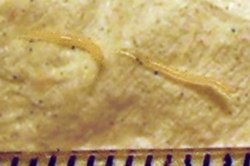| Revision as of 05:35, 30 August 2006 editOpelio (talk | contribs)Extended confirmed users4,111 edits Revert to revision 72295264 dated 2006-08-28 01:10:25 by Blacklobster using popups← Previous edit | Revision as of 14:22, 30 August 2006 edit undo24.213.132.9 (talk) →DiagnosisNext edit → | ||
| Line 28: | Line 28: | ||
| == Diagnosis == | == Diagnosis == | ||
| Diagnosis is often made clinically by observing the female worm (or many worms) in the peri-anal region, but can also be made using the ], in the course of which the sticky side of a strip of cellophane tape is pressed against the peri-anal skin, then examined under a microscope for pinworm eggs. | Diagnosis is often made clinically by observing the female worm (or many worms) in the peri-anal region, but can also be made using the ], in the course of which the sticky side of a strip of cellophane tape is pressed against the peri-anal skin, then examined under a microscope for pinworm eggs. It was always the nasty-ass dirty kids in elementary school who got this stuff. | ||
| ==Treatment== | ==Treatment== | ||
Revision as of 14:22, 30 August 2006
| Pinworm | |
|---|---|

| |
| Two pinworms, captured on emergence from the anus. Markings are 1 mm apart | |
| Scientific classification | |
| Kingdom: | Animalia |
| Phylum: | Nematoda |
| Class: | Secernentea |
| Order: | Rhabditida |
| Family: | Oxyuridae |
| Genus: | Enterobius |
The pinworm (Genus Enterobius) is a parasitic roundworm of the phylum Nematoda.
Forms of worm
The best known is the human pinworm, also known as the threadworms Enterobius vermicularis and the more recently discovered Enterobius gregorii. The adult pinworm male is 1–4 mm in length, while the adult female is 8–13 mm and possess the long, pin-shaped posterior end for which the worm is named. The human pinworm is commonly found in children.
Habitat
The pinworm lives in the lower part of the small intestine, and the upper part of the colon. It is found worldwide and causes the common infection enterobiasis in humans. Unlike many other intestinal parasites, the pinworm does not usually enter the bloodstream or any other organs besides the intestines. Only in rare cases disoriented pinworms can be found in the vagina, and even more rarely in the uterus, fallopian tubes, liver and peritoneum; but the worms cannot survive long in these places.
Reproduction
After mating the male dies. The female migrates to the anus, and emerges (usually during the night) to deposit about 10,000 to 20,000 eggs in the perianal area (around the anus). It then secretes a substance that causes a very strong itching sensation, inciting the host to scratch the area and thus transfer some of the eggs to the fingers. Eggs can also be transferred to cloth, toys and the bathtub. Once ingested orally, the larvae hatch and migrate back to the intestine, growing to maturity in 30-45 days. The eggs can survive from 2 to 3 weeks on their own outside of the human body. (SOURCES: Rudolph's Pediatrics - 21st Ed. 2003; Current Medical Diagnosis & Treatment - 45th Ed. 2006)
Effects
Except for itching, it does not usually cause any damage to the body. Sleep disturbance may arise from the itching or crawling sensations. Some case reports suggest that severe infestation may be associated with an increased risk for appendicitis. There is also some evidence of an association between enterobiasis and diminished zinc levels.
Diagnosis
Diagnosis is often made clinically by observing the female worm (or many worms) in the peri-anal region, but can also be made using the "scotch-tape" test, in the course of which the sticky side of a strip of cellophane tape is pressed against the peri-anal skin, then examined under a microscope for pinworm eggs. It was always the nasty-ass dirty kids in elementary school who got this stuff.
Treatment
Anti-pinworm drugs such as Albenza (albendazole) or Vermox (mebendazole) are commonly used to treat pinworms. It is not a necessity to visit a doctor to get these drugs, as they are commonly available as over the counter medications; ask a pharmacist for medicines to treat pinworms (or threadworms as they are known in the UK). These medicines kill the pinworms 95% of the time, but do not kill the eggs. The person being treated may have to return after a time of two weeks to be retreated. Another precaution towards treating the eradication of pinworms is to wash hands before eating (to prevent any pinworm eggs under fingernails from being ingested) and to wash any area or clothes that have touched or been in the vicinity of the infected areas. Treating the entire family is often necessary for cure.
References
New England Journal of Medicine Video. A 55-year-old man presented with intermittent, crampy pain in the right lower quadrant of the abdomen. A colonoscopy was ordered and revealed multiple mobile 1-cm worms, Enterobius vermicularis, in the cecum.
Images of Parasites: Interobius Vermicularis. Includes pinworm life cycle, signs and symptoms, photographs and drawings of the parasite, and detection procedures.
The Human Pinworm: The human pinworm Enterobius vermicularis is a ubiquitous parasite of man, it being estimated that over 200 million people are infected annually. It is more common in the temperate regions of Western Europe and North America, (it being relatively rare in the tropics) and is found particularly in children. Samples of Caucasian children in the U.S.A. and Canada have shown incidences of infection of between 30% to 80%, with similar levels in Europe.